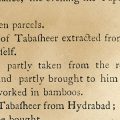Is it science? Is it fiction? Whatever, it’s fantastic!
It’s science! It’s fiction! It’s both! Travel to the surface of the moon, the center of the earth and the depths of the ocean in a new exhibition from Smithsonian Libraries. Fantastic Worlds: Science and Fiction, 1780-1910 is now on view both online (a new chapter is posted each Tuesday) and in the American History Museum’s new Innovation Wing.

The Smithsonian Libraries exhibition “Fantastic Worlds: Science and Fiction, 1780-1910″ officially opend July 1 at the American History Museum. If you can’t make it to DC to see it in person, visit the online version–a new chapter is posted each Tuesday.
Fantastic Worlds explores the intersection of science and fiction in the years between 1780 and 1910, a time that witnessed major inventions and achievements in engineering, including railways, the telegraph and the precursor to the modern computer. Western explorers were reaching the last uncharted corners of the Earth, and new ideas about mankind, the history of the planet and the heavens above were emerging. Experiment, invention and discovery were hallmarks of the era.

Look what popped up! It’s the first chapter of Fantastic Worlds, Science and Fiction, 1780-1910. This first chapter details how accounts of the exploring expeditions to the Arctic and Africa inspired fictional tales of exploration by authors such as Jules Verne.
The public followed these scientific and technological developments with an unprecedented level of interest. These often astonishing discoveries and inventions found their way into fantastic fictional worlds, as writers creatively explored the further reaches of the new scientific landscape, using imagination to craft hoaxes, satires and fictional tales. Fantastic Worlds focuses on themes that have had a lingering afterlife in fiction, exploring the scientific antecedents of stories of lost worlds, fantastic airships, alien life on other planets, mechanical men and adventures both undersea and underground–all major themes that resonate in today’s science fiction.

The second chapter of Fantastic Worlds: Science and Fiction, 1780-1910 is The Age of the Aeronaut. From flights of fancy to realized aeronautics, learn how aviation opened up new realms of scientific observation, adventure, and entertainment. Image is from Samuel G. Goodrich’s The Balloon Travels of Robert Merry and His Young Friends over Various Countries in Europe. New York, 1863
Among the works explored in Fantastic Worlds are Jules Verne’s Twenty Thousand Leagues Under the Sea (Boston: 1873), Mary Shelley’s Frankenstein: or, The Modern Prometheus (London:1831), Rudyard Kipling’s With the Night Mail, a Story of 2000 A.D. (New York: 1909), L. Frank Baum’s Ozma of Oz: A Record of Her Adventures… (Chicago: 1907) and Leopoldo Galluzzo’s Altre scoverte fatte nella luna dal Sigr. Herschel [Other lunar discoveries from Signor Herschel] (Naples: 1836).
Posted: 6 July 2015
- Categories:








